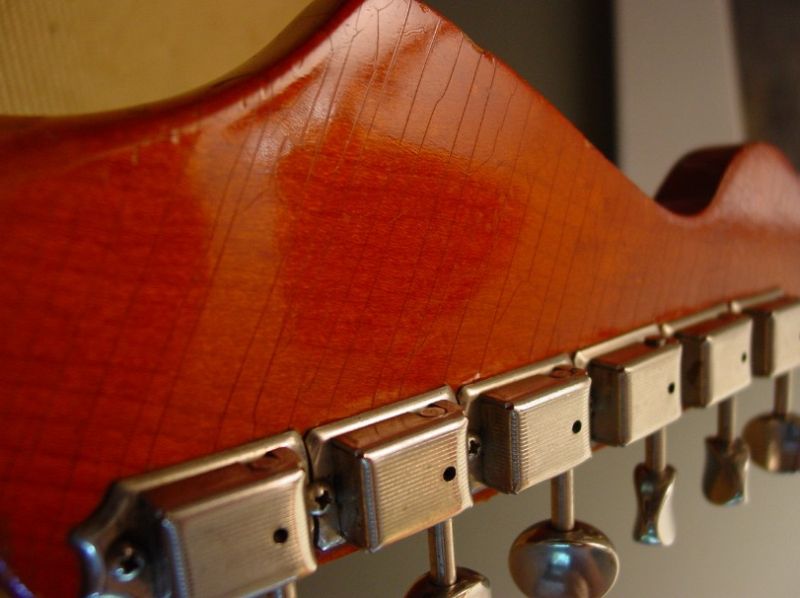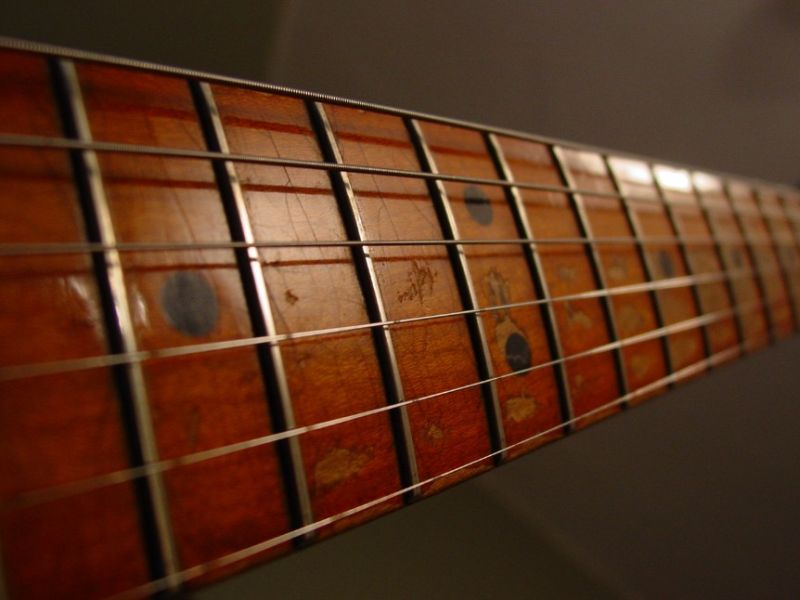Matching a Fender Guitar Crackle Finish
Here's how to crackle lacquer: freeze it with very cold air. February 20, 2008
Question
I need to replace this guitar neck and really don't want to buy an original. So I am using a replacement neck but still want to have an old appearance. I would be using tinted nitro. How would I get it to crack or check like the picture, without all the years of abuse? I hear extreme cold temps.

Click here for higher quality, full size image
Forum Responses
(Finishing Forum)
From contributor G:
Freeze it... Saw a guitar left in a car trunk overnight in the winter and the entire exterior was crazed.
From contributor J:
What about using crackle lacquer?
From contributor L:
I have heard of guys using a razor blade to fake those kinds of lines. It would take a real artistic approach, but...
From contributor A:
The uniform look of the crackle lines indicate that this is most likely done by hand. The razor blade idea might work and may well be how this was done in the photo. It also appears to me that the cracks are of a different colour, indicating that a wash coat (probably gun wash and toner) was put over top and it burnt into the crevices. Silicone also works well when painted on with an artist brush. You then spray the lacquer over it and give it a light sand and spray again. It produces a similar effect. I haven't tried this with a WB yet, but I have some faux finish work coming up where a cracked look is in order and I'll be giving it a go.
From the original questioner:
Thanks for the responses. This is the original finish done in the Fender factory many years ago. I am definitely going to have to use my imagination and do some experimenting with all the ideas. The cracks are very tight. Crackle lacquer may or may not work, followed by some glaze to pop them out. I don't have a lot of experience with the crackle lacquer, but from what I've seen, the cracks are pretty wide. Razor blade might do it for me with some patience. But first I am going to try some hot and cold cycles to see what happens. Keep any more comments coming. I posted another picture to give you a little different idea.

Click here for higher quality, full size image
From contributor I:
Go to your local art store and buy a product called crackle varnish. It is used to duplicate the fine cracks on an antique painting, or like the cracks in pottery glaze.
From contributor R:
I know very little about finishing, but I know more about finishing than my cousin does. However, he knows everything about guitars, and I watched him check crack a freshly lacquered body by spraying it with a can of gas used to clean computers. He said he got the can of gas from Sam's Club. This is exactly what you are looking for. He is a studio musician and most manufacturers just give him free stuff for the free advertising, but he has a lot built to old 50's telecaster specs and the checking is the last step before he starts using it. I was blown away by the gas - just freeze a 3''X3'' square and let it warm back up, takes 15 minutes to make it look 50 years old.
From the original questioner:
Contributor R, you are right on. I came across an article of a demonstration that was done by Fender at a show on how they relic their reissue guitars. They use a can of compressed air held upside down, and spray the entire side of a guitar body until it is frosted up. I guess you could hear the finish cracking. Then they wiped it down with some alcohol with colored dye to pop out the cracks. I also found that some use a can of "freeze it" which is an aerosol that they use to cool circuit boards. It comes out at -100 degrees. I think that will about wrap this thread up. Thanks everyone.

